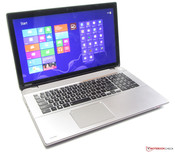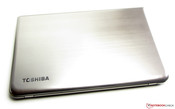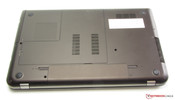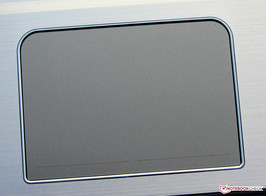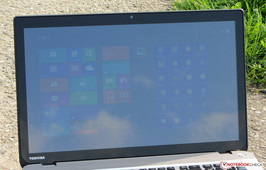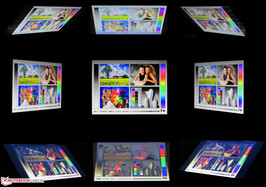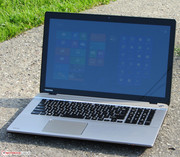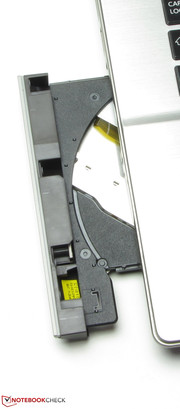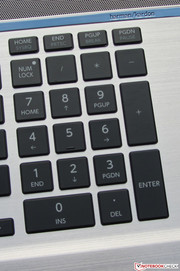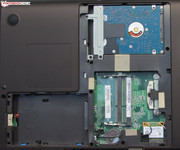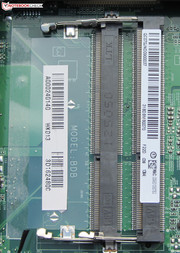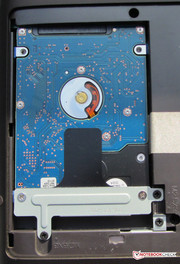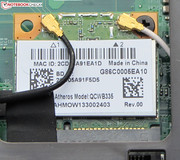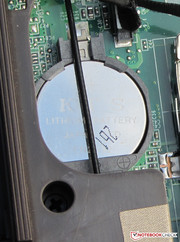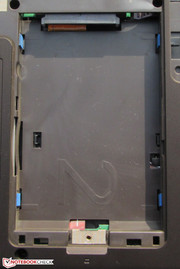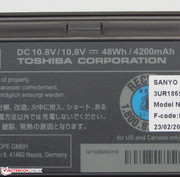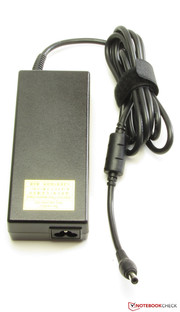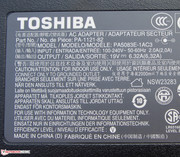Hands-on Toshiba Satellite P70 Pre-production Notebook

For the original German preview, see here.
Toshiba has granted us a sneak preview of a pre-production model of the new Satellite P70 series. The notebook is Toshiba's premium model for the consumer sector. It is equipped with a Haswell Processor (Core i7-4700MQ) and a GeForce GT 745M GPU. According to Toshiba, the device does not yet have the final BIOS and Windows installations. Therefore, we cannot provide you with any benchmark results. The workmanship is also not indicative of the future production version.
Case
The casing of the Toshiba Satellite P70 is made of metal and plastic. The top side of the base unit and the back of the display lid are made of brushed aluminum. The bottom of the base unit and the screen bezel are made of black plastic. The base unit has rounded edges and the back corners have a much more pronounced curvature. The touchpad takes on the form of the base unit. It is separated from the palm rest by a shiny metal frame. Above the keyboard there is a metal mesh, behind which are the speakers. The power button is located at the top right and is surrounded by a white LED ring.
The base unit seems to withstand pressure very well. Unfortunately, it can be twisted too easily. Thanks to its metal back, the display lid cannot be bent as easily. The lid also seems pressure resistant as well. Minor image alterations are noticeable only in a few places. The hinges hold the display firmly in position and teeter only slightly. The hinges seem to be too tight for one-handed opening. According to Toshiba, the workmanship is still not of the quality of the production model. Nevertheless, the pre-production version has already left a good impression.
Connectivity
Toshiba has equipped the Satellite with the usual interfaces. Positive: all four of the USB ports support the USB 3.0 standard. According to Toshiba, the HDMI port supports the output of videos in 4K resolution (Ultra HD; about four times the resolution of Full HD). The ports on the right side of the notebook are located uncomfortably to the front. The interfaces on the left side are further back.
Communication
A WLAN module by Atheros (AR9565) has found its way into the Satellite P70. It supports the usual 802.11 b/g/n standards. The wireless module did not cause any problems. However, the aluminum display lid seems to somewhat hinder the reception. The Windows WLAN indicator shows only four out of five bars, even in direct proximity (about 3 meters) to the router. Two floors below the router (about 50% transmission power) resulted in only three out of five bars. The Gigabit Ethernet chip (AR8161/8165) of the P70 is also made by Atheros. There is also a Bluetooth 4.0 module. The integrated webcam (0.9 megapixels) delivers a blurred image with up to 1280x720 pixels.
Accessories
The accessories and software package are not indicative of the production model. Therefore we cannot give you any information.
Operating system and Recovery
The Satellite P70 will be delivered with preinstalled Windows 8 (64-bit). There is no Windows DVD in the package. It is therefore advisable to make a set of recovery DVDs with the preinstalled Toshiba Recovery Media Creator. This way the system can be loaded again in the event of a hard drive replacement. The usual recovery system in Windows 8 notebook, used for system repairs, can be accessed by pressing the F10 key immediately after turning the laptop on.
Maintenance
Removing the maintenance cover gives us access to two RAM slots, the hard drive, the WLAN module, and the BIOS battery. The fan is not accessible. The first thing we notice is that the two memory slots are empty. The notebook is equipped with a total of four RAM slots. Further disassembling of the notebook is required in order to access the other two memory slots. They are taken up by a total of 4 GB RAM (2 modules, 2 GB each). The system memory operates in dual channel mode. Replacing the hard drive is also easy. Both 7 mm and 9.5 mm models can fit into the notebook. The Satellite also has room for a second hard drive.
Input Devices
Keyboard
Toshiba has installed a backlit chiclet keyboard in the Satellite P70. It has three operating modes: off, permanently on, and briefly switched on following a key press. The main keys are 15 x 15 mm large. The smooth, flat keys have a short stroke and clear pressure point. The resistance of the keys is also good - not too soft and not too hard. Overall, the keyboard delivers a pleasant typing experience. The CapsLock and NumLock keys are equipped with LEDs that show their current status.
Touchpad
As a mouse replacement we have an 11.2 x 7.8 cm large multi-touch Clickpad. A Clickpad is a touchpad without separate mouse buttons - the whole pad is one key. Depending on the finger position at the lower half of the pad, it recognizes a left or right mouse click. The smooth surface of the pad makes the finger gliding easy. The various multi-touch gestures can be switched on and off individually in the configuration menu. By default not all of the gestures are activated. A quick double tap in the upper left corner switches the touchpad on and off. The current status of the pad in shown via a built-in LED. The Clickpad has a short stroke and a clear audible and tactile feedback.
Display
Toshiba has equipped the Satellite with a glossy 17.3-inch display by AU Optronics. The display has a Full HD resolution (1920x1080 pixels). The average brightness is 283.3 cd/m². It is likely that Toshiba will offer the P70 series with a lower-resolution display (1600x900) in order to be able to offer lower-priced models.
| |||||||||||||||||||||||||
Brightness Distribution: 85 %
Center on Battery: 146 cd/m²
Contrast: 639:1 (Black: 0.485 cd/m²)
ΔE ColorChecker Calman: 9.97 | ∀{0.5-29.43 Ø4.78}
ΔE Greyscale Calman: 11.13 | ∀{0.09-98 Ø5}
64.9% AdobeRGB 1998 (Argyll 3D)
88.7% sRGB (Argyll 3D)
67% Display P3 (Argyll 3D)
Gamma: 2.48
The contrast ratio (639:1) and black level (0.485 cd/²) of the screen are also good. The display cannot cover the AdobeRGB and sRGB color spaces.
We tested the screen with its factory settings (target color space sRGB) and we measured significant DeltaE 2000 deviations in many colors. In addition, the display has a strong blue tint. These values improved greatly after calibration. The DeltaE 2000 values for most colors decreased down to less than 5. Only orange, yellow orange, blue, and purplish blue slightly exceeded this value (DeltaE between 5 and 6.5). Even the blue tint was gone after calibration. We hope that Toshiba will deliver the P70 series notebooks with a good color profile. After all, few buyers have a photo spectrometer for calibration at hand.
On battery power the screen brightness significantly decreases, making it hard to work outdoors. We measured a maximum brightness of 146 cd/m², which is too low for our taste. It may be the case that there is a bug in the Windows installation of the P70, which causes this significant drop in the brightness. Things might look differently in the production model. The problem is not caused by a light sensor, since the P70 does not have one. Just to be sure, we kept the camera brightly lit (lamp) during the test.
The usability outdoors is not a big issue for a notebook like the P70 anyway. The weight, size and hardware make it far more suitable for desktop use, near a power outlet.
The display of the Satellite is one of the better models of the TN type (not IPS!). Vertically, the viewing angles are far more stable than what we are used to with many low-cost notebooks. Only a view from below causes the image to distort. Horizontally, things look much better. The screen content can be read even from the sides.
Performance
Toshiba's Satellite P70 is a DTR notebook of the higher class of consumer laptops. The installed hardware is sufficient for all the usual applications, such as video playback and internet communications. Even demanding 3D games and video editing are not a problem for the notebook.
Processor
Our test model is powered by a representative of Intel's new Haswell processor generation: the Core i7-4700MQ quad-core processor. The CPU operates at a base clock frequency of 2.4 GHz. Thanks to the Turbo function, the core speed can be increased to 3.2 GHz (all four cores), 3.3 GHz (2 cores) or 3.4 GHz (one core only). Thanks to the improvements of the Haswell architecture, the processor should be about 10% faster than the Ivy Bridge predecessor, the Core i7-3630QM. The TDP of the Core i7-4700MQ is 47 W. Therefore it is 2 W higher than that of its predecessor. The processor completed the single-thread Cinebench Benchmarks with a clock frequency of 3.2 to 3.3 GHz. The multi-thread tests were completed at 3.2 GHz.
System Performance
Although Toshiba explicitly says that the hard drive image and the BIOS of the P70 are different from the production model, the system performance of the pre-production model is still good. The system works well, Windows 8 starts rapidly. The quick system start-up might cause the confusion that the notebook has an SSD, but this is not the case.
Storage Device
The P70 is equipped with a hard drive from the HGST Travelstar 5K1000 series. It has a capacity of 750 GB and operates at 5400 rpm. CrystalDiskMark measured a read rate of 108.5 MB/s. HD Tune showed an average transfer rate of 87.1 MB/s. These are very good results for a 5400 rpm hard drive. The access time of 17.7 ms is also acceptable.
Graphics card
The Satellite P70 has two brand new GPUs. These are the Intel HD Graphics 4600 GPU and Nvidia's GeForce GT 745M. The graphics chip by Intel is designed for everyday tasks. The GeForce is used for applications such as 3D games. Both cards support DirectX 11.1. Our review contains extensive information and benchmark results for Intel's new graphics chip. The GT 745M graphics card belongs to the upper middle class. It operates at a base core frequency of 837 MHz. Thanks to the Turbo functionality it can be increased further. The P70 also takes advantage of this Turbo function.
Emissions
System Noise
Even in idle state, the P70 is not particularly quiet. We measured a noise level of 32.1 to 37 dB(A). The positive side effect of the constantly operating fan is that the case does not heat up at all in idle state. Under medium (3DMark06) and full load (stress test, Prime95 and Furmark simultaneously), the fan must work vigorously in order to cool down the powerful hardware. We measured a noise level of 40.4 and 41.3 dB(A) respectively.
Noise level
| Idle |
| 32.1 / 32.3 / 37 dB(A) |
| HDD |
| 33 dB(A) |
| DVD |
| 35.9 / dB(A) |
| Load |
| 40.4 / 41.3 dB(A) |
 | ||
30 dB silent 40 dB(A) audible 50 dB(A) loud |
||
min: | ||
Temperature
The Satellite surprised us in idle state with case temperatures of below 30 °C. This is thanks to the fan, which is constantly working even in idle. Even under full load (Prime95 and Furmark simultaneously), the notebook's cooling system works well. Only at two spots on the bottom did we measure very high temperatures of 53.5 and 60.5 °C. The air blown out of the case is rather hot and therefore it is not advisable to keep your hand next to the opening. The powerful hardware is the cause of these temperatures.
The CPU completed our stress test (Prime95 and Furmark running for at least an hour) on AC power at two speeds: 800 MHz and 3.2 GHz. The CPU alternated between these two frequencies, probably for reasons concerned with the cooling system. When the CPU works at 3.2 GHz, the temperatures reach almost 100 °C. At 800 MHz the temperatures are 80 °C. When we rаn the stress test on battery power, the CPU rаn constantly at 800 MHz. The GPU completed the stress test on both AC and battery power with its full Turbo frequency. We ran the 3DMark06 benchmark when the notebook was cool and immediately after the stress test. In both cases the P70 showed the same results.
(-) The maximum temperature on the upper side is 46.3 °C / 115 F, compared to the average of 36.9 °C / 98 F, ranging from 21.1 to 71 °C for the class Multimedia.
(-) The bottom heats up to a maximum of 60.5 °C / 141 F, compared to the average of 39.2 °C / 103 F
(+) In idle usage, the average temperature for the upper side is 23.4 °C / 74 F, compared to the device average of 31.3 °C / 88 F.
(±) The palmrests and touchpad can get very hot to the touch with a maximum of 39.1 °C / 102.4 F.
(-) The average temperature of the palmrest area of similar devices was 28.7 °C / 83.7 F (-10.4 °C / -18.7 F).
Speakers
Toshiba has equipped the Satellite with a 2x2 speaker system by Harman/Kardon. The two speakers are located behind a perforated metal panel above the keyboard. They produce a very pleasant, full-bodied sound. There is even some bass, but it lacks power. Watching movies on the notebook is easy and does not cause frustration because of the sound quality. Those who do not find the integrated speakers to be sufficient can connect headphones or external speakers.
Energy Management
Power Consumption
The pre-production model we received came with a large and heavy power supply, which can provide a maximum of 120 W. It is already clear that the Satellite is not among the low-consumption notebooks. In idle state, the power consumption is between 11.8 and 17.2 W. These values are perfectly in order for a 17.3-inch notebook with a bright Full HD display. Under medium load (3DMark06) the energy consumption increases significantly to 83.5 W. Under full load (Prime95 and Furmark) consumption was between 69 and 114 W. The CPU throttling, which we saw in the stress test, is noticeable here.
| Off / Standby | |
| Idle | |
| Load |
|
Key:
min: | |
Battery Life
In idle state the P70 reached a time of 4:14 h. The idle state was simulated by the Battery Eater Reader's Test. The brightness is set at minimum, the energy saving profile is activated and the wireless modules are turned off. Under load the battery was empty after only 45 minutes. This runtime was measured with the help of the Battery Eater Classic Test. The brightness was set at maximum, the high performance profile and the wireless modules were activated.
In the WLAN test the P70 managed to last 2:41 h. During this test websites were automatically loaded every 40 seconds. The energy saving profile was chosen and the brightness was set at 150 cd/m². The DVD playback ended after 2:23 h. This test was done with the energy saving profile on (or higher if the DVD did not run smoothly), maximum display brightness and deactivated wireless modules.
The Satellite P70 has powerful hardware and therefore our expectations for the battery life were not particularly high. The battery of the P70 has a capacity of 48 Wh.
Verdict
What Toshiba has offered here is a visually successful DTR notebook. At least on paper, the installed hardware promises a lot of performance in applications and games. We liked the bright, high-contrast display and the keyboard that offers a comfortable typing experience. In addition, the fast hard drive provides plenty of storage space, and let us not forget the great audio system. The powerful hardware of the P70 must be sufficiently cooled and therefore the fan works constantly. The battery life is not very good, but we did not expect anything different given the hardware configuration. Battery life tends to have a secondary role in a DTR notebook anyway.
As soon as a production device becomes available, we will do our best and follow up with a detailed review containing scores. Then we can determine how good the performance in benchmarks is and whether the CPU throttling interferes with everyday use or not.




